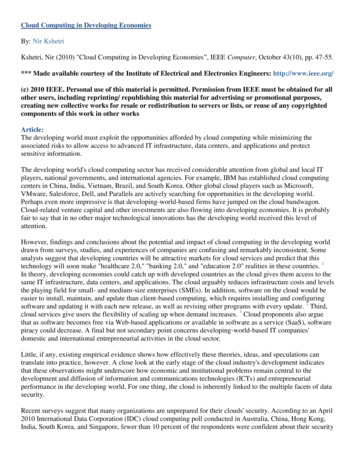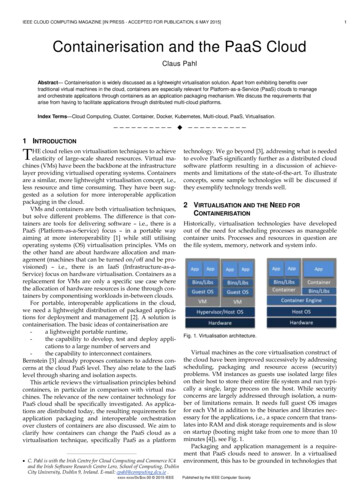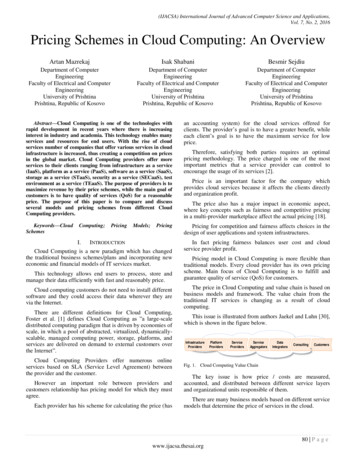
Transcription
Cloud Computing in Developing EconomiesBy: Nir KshetriKshetri, Nir (2010) "Cloud Computing in Developing Economies”, IEEE Computer, October 43(10), pp. 47-55.*** Made available courtesy of the Institute of Electrical and Electronics Engineers: http://www.ieee.org/(c) 2010 IEEE. Personal use of this material is permitted. Permission from IEEE must be obtained for allother users, including reprinting/ republishing this material for advertising or promotional purposes,creating new collective works for resale or redistribution to servers or lists, or reuse of any copyrightedcomponents of this work in other worksArticle:The developing world must exploit the opportunities afforded by cloud computing while minimizing theassociated risks to allow access to advanced IT infrastructure, data centers, and applications and protectsensitive information.The developing world's cloud computing sector has received considerable attention from global and local ITplayers, national governments, and international agencies. For example, IBM has established cloud computingcenters in China, India, Vietnam, Brazil, and South Korea. Other global cloud players such as Microsoft,VMware, Salesforce, Dell, and Parallels are actively searching for opportunities in the developing world.Perhaps even more impressive is that developing-world-based firms have jumped on the cloud bandwagon.Cloud-related venture capital and other investments are also flowing into developing economies. It is probablyfair to say that in no other major technological innovations has the developing world received this level ofattention.However, findings and conclusions about the potential and impact of cloud computing in the developing worlddrawn from surveys, studies, and experiences of companies are confusing and remarkably inconsistent. Someanalysts suggest that developing countries will be attractive markets for cloud services and predict that thistechnology will soon make "healthcare 2.0," "banking 2.0," and "education 2.0" realities in these countries. 1In theory, developing economies could catch up with developed countries as the cloud gives them access to thesame IT infrastructure, data centers, and applications. The cloud arguably reduces infrastructure costs and levelsthe playing field for small- and medium-size enterprises (SMEs). In addition, software on the cloud would beeasier to install, maintain, and update than client-based computing, which requires installing and configuringsoftware and updating it with each new release, as well as revising other programs with every update. 2 Third,cloud services give users the flexibility of scaling up when demand increases. 3 Cloud proponents also arguethat as software becomes free via Web-based applications or available in software as a service (SaaS), softwarepiracy could decrease. A final but not secondary point concerns developing-world-based IT companies'domestic and international entrepreneurial activities in the cloud sector.Little, if any, existing empirical evidence shows how effectively these theories, ideas, and speculations cantranslate into practice, however. A close look at the early stage of the cloud industry's development indicatesthat these observations might underscore how economic and institutional problems remain central to thedevelopment and diffusion of information and communications technologies (ICTs) and entrepreneurialperformance in the developing world. For one thing, the cloud is inherently linked to the multiple facets of datasecurity.Recent surveys suggest that many organizations are unprepared for their clouds' security. According to an April2010 International Data Corporation (IDC) cloud computing poll conducted in Australia, China, Hong Kong,India, South Korea, and Singapore, fewer than 10 percent of the respondents were confident about their security
measures. 4 Critics have also raised concerns about poor bandwidth and a lack of forward and backwardlinkages. What is theoretically possible, versus what is practically achievable, is thus the critical issue.STATE OF CLOUD COMPUTING IN DEVELOPING ECONOMIESIt's important to make clear at the outset that cloud computing in the developing world is in its infant stage.Studies have indicated a lack of cloud awareness, even among large companies. According to a 2009 Gartnersurvey of large enterprises, half the respondents in emerging markets either hadn't heard of cloud computing ordidn't know what it was. 5IT-intensive areas such as offshoring and software development are enthusiastically embracing clouds. In India,cloud demand is high in the offshoring industry and technology hubs. In South Africa, the call center industryhas been the fastest growing area for the cloud. Likewise, the IBM Cloud Center in China's Wuxi City targetssoftware developers.The market for the cloud in developing countries is small but expanding rapidly. An IDC study suggested thatemerging markets such as Brazil, Russia, India, and China will likely be important forces driving the globalshift toward the cloud, 6 with China and India having the greatest mid- to long-term potential for the cloud. Thereport also predicted that the Indian SaaS market would experience a compound annual growth rate of 77percent during 2006-2010. India's National Association of Software and Services Companies and McKinseyestimated that remote infrastructure management will be a US 15 billion industry in India by 2013.Cloud-related activities in the developing world are mainly concentrated in big economies such as China, India,Brazil, South Africa, and Vietnam. Nonetheless, the cloud is gradually making an inroad into smallereconomies, as Table 1 illustrates. Dell reported that it might offer cloud services in Saudi Arabia and otherMiddle Eastern countries by the end of 2010. Likewise, in April 2010, Microsoft and Qatar Telecom (Qtel)signed a strategic alliance to offer cloud-based services, applications, and devices over Qtel's network. Kenyancompanies are also showing interest in the cloud. 7Table 1. Current cloud computing application areas in developing countries.Application areasE-education. E-education has received particular attention. The Computational Intelligence Research Group atthe University of Pretoria, South Africa, uses the cloud for next-generation medical research. Universitystudents use the cloud to conduct research in the development of drugs for the treatment of Africa-specificserious illnesses.In East Africa, the Higher Education Alliance for Leadership through Health (Health Alliance), a consortium ofseven universities (universities in Kenya, Jimma University in Ethiopia, the University of Kinshasa in theDemocratic Republic of Congo, Muhimbili University of Health and Allied Sciences in Tanzania, and Makerere
University in Uganda), is working with industry experts to extend education through virtual computing labs thatstudents access remotely.Universities in China, Qatar, and Turkey are among the 17 educational institutions worldwide participating inthe IBM Cloud Academy, which allows access to a range of educational resources. In addition, Chineseuniversities can access a supercomputer to analyze data on disease-spread patterns and climate changes.Likewise, Indian universities are banking on the cloud to develop innovative research and education activities.The Indian Institute of Technology, Kanpur, and other academic institutions have also adopted the cloud.Although less well known in the global IT map, Vietnam has recently come into the limelight due to itscontributions to development of the cloud, especially in e-education. Vietnamese government institutions anduniversities use the cloud to develop education programs. Vietnam National University (VNU) has established acloud platform. IBM and VNU have signed a memorandum of understanding about using the cloud to build ITskills.E-health. Another visible application of the cloud is in healthcare. India's ICICI Bank's insurance arm has usedZoho's Web-based applications to develop services such as personalized insurance for patients with diabetes.The company adjusts premiums based on how well policy-holders stick to a fitness plan. 1Likewise, in May 2009, IBM opened a Healthcare Industry Solution Lab in Beijing. The lab will work withhospitals and rural medical cooperatives. The Guang Dong Hospital of Traditional Chinese Medicine hasimplemented a suite of healthcare data-sharing and analytics technologies, known as Clinical and HealthRecords Analytics and Sharing. CHAS combines input from traditional Chinese medicine and modern Westernmedicine. Hospitals use CHAS to share electronic medical records (EMRs) incorporating this data across thehospital network.E-commerce, e-business, and supply chain. Yet another major application of the cloud has been in ecommerce and supply-chain management.In China, IBM's pilot project Yun (Chinese for "cloud") lets businesses select and implement cloud services.The platform dynamically allocates storage, server, and network resources without human input.The Wang Fu Jing department store, one of China's largest retailers with more than 10 million customers, hasdeployed cloud computing in supply-chain management, which it uses to share information with its network ofretail stores and implement business-to-business e-commerce.In Korea, banking, telecommunications, and IT hosting services use the cloud; while in South Africa, Nedbankis automating its business processes through the cloud.Emerging application areas. Emerging application areas in developing countries include e-government, eenvironment, and telecommuting.Vietnam's Ministries of Education and Training, Science and Technology, and Information andCommunications have jointly developed cloud-based academic programs that offer computing courses, freesoftware tools, and business case studies.In China, scientists have access to a supercomputer that lets them analyze climate change data. In West Africa,the UK's Hadley Center for Climate Prediction and Research is negotiating with Amazon to sponsor aresearcher for free access to cloud services.South Africa is a leader in using the cloud to support telecommuting. Call center agents and software developerscan log in from anywhere using IP lines or a virtual private network (VPN).
Supporting trendsSeveral trends facilitate the cloud's diffusion in developing countries.Multinationals' search for opportunities. The activities of several companies triggered the cloud industry'sevolution in the developing world. In 2008, IBM opened a cloud center in Bangalore, India, that targets midmarket vendors, universities, government bodies, and microfinance and telecommunications companies. Thatsame year, IBM opened a similar center in Beijing. Cloud computing is also a primary R&D area in its China'sShanghai facility. In addition, IBM has built data centers to offer cloud services in Johannesburg, South Africa,and Hanoi, Vietnam.Microsoft's cloud offerings in developing countries include the Business Productivity and Online Suite (BPOS),Windows Azure (a platform for building, deploying, and selling applications on the cloud), and an infrastructuresuite to build private and public clouds. Developers in Malaysia, India, and China can use Visual Studio 2010,launched in April 2010, to build applications for Azure. BPOS, which consists of e-mail, live meeting, andcollaboration tools, was launched commercially in India in November 2009 and by April 2010 had 15,000 usersin 600 organizations. 8Salesforce, which started its operations in India in 2005, focuses on major cities and is creating cloud awarenessthrough its SaaS products. Its customer base in India grew by 42 percent during its fiscal year ending in January2010.By mid-2009, VMware was active in developing economies such as India and South Africa. Likewise, the UScompany Parallels announced a plan to establish cloud operations in India. Similarly, Computer SciencesCorporation announced that it would develop its Vietnamese operation as a cloud center. In the same vein, inJuly 2010, Japanese technology company NEC announced a plan to launch cloud services in China in 2011.Governments' and international organizations' efforts. Vietnam and China are notable examples ofeconomies that have meaningful government interventions in the cloud sector. Cloud computing in Vietnam isdriven fundamentally by the government's belief that this technology will help the country build a skilledworkforce, and universities, government ministries, and telecommunication vendors have adopted the cloud.One government agency uses the cloud to link government agencies, universities, private-sector research, startups, and other organizations. 9 Vietnam has been collaborating with IBM since 2007 on a pilot cloud program.International agencies have facilitated cloud uses in some of the least developed countries. For instance,UNESCO and Hewlett-Packard have teamed up in the brain gain initiative, which harnesses the powers of thecloud and grid computing to slow brain drain in Africa and Arabic countries. The initiative gives researchersaccess to global scientific networks and computing power, letting them collaborate with experts around theworld. 10 Burkina Faso's University of Ouagadougou launched two projects under the brain-drain initiative:modeling the movement of pollutants in the Sourou River drainage basin and implementing a high-performancecomputing grid. UNESCO and HP launched the initiative in five universities between 2006 and 2009. They planto find partners and include 100 more universities by 2011.Local firms' cloud-related entrepreneurial activities. Local firms have also contributed to the cloud's growthin developing countries.In 2009, the Brazilian firm Stefanini IT Solutions invested US 218,700 to boost cloud offerings. Similarly,China's Alibaba Group announced it would spend US 146 million in developing software, marketing, andestablishing cloud centers that provide SaaS, esp
Cloud Computing in Developing Economies By: Nir Kshetri Kshetri, Nir . Little, if any, existing empirical evidence shows how effectively these theories, ideas, and speculations can translate into practice, however. A close look at the early stage of the cloud industry's development indicates that these observations might underscore how economic and institutional problems remain central to .











